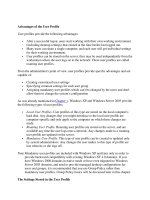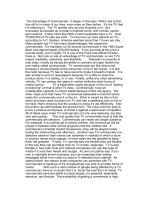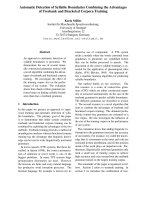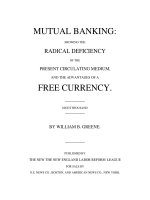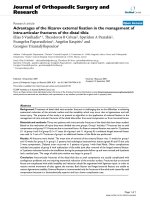Advantages of template
Bạn đang xem bản rút gọn của tài liệu. Xem và tải ngay bản đầy đủ của tài liệu tại đây (58.12 KB, 4 trang )
Advantages of template.
1. The main advantage is that templates significantly simplify the generation of good company
documentation, which allows you to invest valuable time in the content and review of these
documents. Templates are the skeletons which constitute the basis of your documentation. Once
you start filling them with useful content, these skeletons will turn into flesh and blood.
2. .Simplify document creation
Templates can not only ease your workload but also make you feel less stressed and at the same
increase your efficiency. Besides, they help inexperienced staff produce professional-looking
documents that easily follow the company house style.
3.
Save time and money
Utilizing readymade templates is less time-consuming than creating documents from the ground
up. Eventually, it results in cost saving for a company. The cost of creating reusable preset forms
will be considerably less expensive than having to reinvent documents every time they are
needed.
4. Consistency and clarity
One of the core benefits of templates is visible to the naked eye.
Choice of Designs — There are hundreds of template designs to choose from online. You don’t have to
envision the kind of Web site you want created and then describe it to the designer. Instead, what you see
is what you get. Because the template is premade, you can also “test drive” the design beforehand to see
how visitors will navigate around your site and how it all goes together.
Ready to Go— You can start building your Web site more or less instantly. You don’t have to wait for the
designer to build the site. Instead, with a template, as soon as you have paid, you get a download link and
can then get started adding your content and images. You could have your site up and running in a matter
of hours!
Inexpensive— Some templates are free, others you have to pay for, but compared to custom Web site
design, template design is an inexpensive way to get your business online.
Disadvantages:
Limitations— As your business grows, you will want to expand your Web site. With a template this may
be difficult. Let’s say you choose a Web site template that has limited space for navigation links. In the
beginning, those seven spots were fine for linking to your home page, contact, about and four product
pages. But as you add more pages and sections where are you going to link to them?
Unoriginal Design — Some Web site templates are plain and unoriginal; they generally don’t have the
“wow factor” of a custom-made site. Plus one template design can be downloaded multiple times. Sure,
you can add in your own logo and change the colors, but the design is not going to be unique to you and
may look similar to John Doe’s.
Knowledge — Do you know how to optimize images, how to make a HTML link and how to
add shopping cart buttons? Do you have a Web site building program such as FrontPage or
Dreamweaver? With custom Web site design the designer can insert all your images and content into the
site as well as get the shopping cart up and running. With a template design you will have to do all of that
yourself or hire someone else to do it.
Restrictive
Application templates are usually designed to help you produce results as quickly and as conveniently as
possible, but in many cases the customization options can be limited, restricting what you can do with
your files. If you aren't familiar with the product in question, then it's likely that you won't know how to
make the necessary edits and modifications to the template to make it your own. In other cases, the
template won't be able to be customized in the way you would like, leaving you with an end result that
you're not happy with.
COMMUNICATE PERSUASIVELY
BUILD A RELATIONSHIP WITH YOUR AUDIENCE (CUSTOMERS).In order to sell yourself, your
company, your product, or your service, you must first establish a relationship with your customers—the
audience for your message. This process is also known as building rapport. Rapport refers to relationships
of mutual trust among people, feelings of sympathetic understanding and sympathetic compatibility. In
short, people pay attention to those they trust, have confidence in, look up to, and respect.
UNDERSTAND YOUR AUDIENCE’S WANTS AND NEED
A persuasive presentation, obviously, aims to persuade the audience to take some kind of action—read
your article, brochure or proposal; click a link; make a purchase or take some other desired action. But if
you don’t know what your audience wants or needs, you won’t be able to persuade them to accept your
solution. After all, people take specific actions because doing so fulfills a particular want or need
When your message doesn’t speak to your audience’s desires and needs, it is going to be ignored every
time. So if you want people to pay attention, you have to quickly grab their interest and engage them
because your audience only cares about what you do when you can meet their wants and needs.
It isn’t enough to simply know what their wants and needs are. Your message also needs to explicitly
address their concerns and speak to their interests, values and aspirations. You must tailor your message to
clearly demonstrate how you, your product, or your service delivers benefits that fulfill your audience’s
wishes or needs.
Use Body Language
With verbal communication, your demeanor influences your ability to persuade as much as your words.
If you cross your arms, your audience may perceive you as hostile or angry. If you fidget, they may see
you as weak or uncertain. If you rarely make eye contact, they may think you're hiding something. To
sell your message to your audience, connect with them by maintaining eye contact. Project authority
and confidence by standing up straight. Demonstrate your sincerity and openness by relaxing your arms
and keeping them at your sides – unless you're using them to gesture – instead of crossing them behind
or in front of you.
Get the Audience's Attention
Before you can persuade an audience, you must first grab their attention and demonstrate why it's worth
their time to listen to your idea or suggestion. Start with an anecdote that illustrates the point you're
trying to make or with a surprising fact that tells them why what you have to say is important. For
example, if you're trying to persuade company management to adopt a no-smoking policy, begin with a
statistic regarding how many sick days smokers take compared to non-smokers.
Establish Credibility
To persuade an audience, you must demonstrate your credibility and authority. People are more
receptive to someone they view as an authority figure, whether that person has direct authority over
them, such as a boss, or if the person is an authority in his industry or profession. You should attempt to
persuade others of something you can prove or have first-hand knowledge of or experience in. Back up
your claims with statistics or examples.
Ask intelligent, open-ended questions. Asking good questions is one of the most important ways to
communicate more successfully. When you are met with resistance, probe. Go deep enough so that you
walk away from the conversation with new information and insight (instead of walking away emptyhanded and frustrated). Learn more — their position, challenges, needs and areas of confusion — so that
you can help them move beyond their resistance and into their comfort zone. Show up prepared with
intelligent questions. Being prepared for tough conversations beats winging it every time.
HOW TO USE CORRECT & EFFECTIVE SENTENCES
Build your vocabulary: Nothing makes a sentence sing like words that are precise and vivid. Expand your
arsenal by building your vocabulary. Read a lot and look up words you don’t know. Peruse the dictionary.
Sign up for a word-of-the-day newsletter. Keep a log of vocabulary words and spend a minute or two each
day adding to it and studying your new words. One of the best ways to master language and vocabulary is
through poetry exercises.
Avoid repetition: Nothing deflates a piece of writing like the same descriptive word unnecessarily used
over and over. She had a pretty smile. She wore a pretty dress. She lived in a pretty house. This kind of
repetition robs a story of its imagery, making it flat and two-dimensional.
Use a thesaurus: A thesaurus will help you avoid unnecessary repetition. Many writers avoid thesauri,
thinking that reliance on one constitutes some writerly weakness. But your job is not to be a dictionary or
a word bank; it’s knowing how to find the perfect words and then use them when writing effective
sentences.
Read drafts aloud to check the rhythm and flow: Reading aloud is great for catching mistakes and typos,
but it can also help you with flow and rhythm. Take it a step further and record yourself reading an
excerpt aloud. Does it flow naturally? If you keep tripping over your own sentences, there may be a
problem with rhythm. Try alternating sentence lengths, breaking long sentences into shorter sentences,
and joining sentences together to fix the flow.
Pay attention to word choice: Why refer to something as a loud noise when you can call it a roar, a din, or
a commotion? The more specific you are in your writing, the more easily the reader will be able to
visualize whatever you’re communicating. Choose words that are as precise, accurate, and detailed as
possible.
Simplify: Run-on sentences and short sentences strung together with commas and conjunctions create a
lot of dust and noise in a piece of writing. In most cases, simple, straightforward language helps bring the
action of a story to center stage. Use the simple subject-verb-object sentence structure to keep the text
flowing and prevent readers from getting confused.
Avoid filler words: I’ve gone back to this article several times since I first read it and have already passed
it along to several writers I work with. In short, don’t tell the reader what the character is thinking,
wondering, or feeling unless it’s essential to the narrative. Let the story’s action take its course and move
the story forward.
Brush up on grammar: Nothing will clean up your writing more than using good, old-fashioned grammar.
Pick up a grammar or style guide (a good starter is the Elements of Style) and spend some time mastering
the rules. Yes, rules are made to be broken, but make sure you have a good reason when you break the
rules, and make sure doing so doesn’t impede the readability of your work.
